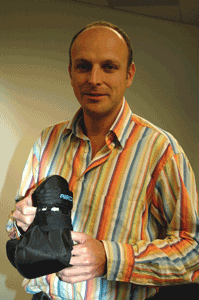
Introduction
The AIRCAST® AIRLIFT™ PTTD BRACE, an off-the-shelf brace, is designed for the treatment of posterior tibial tendon dysfunction (PTTD), or for early signs and symptoms of the adult acquired flat foot.
Depending on the severity of the condition, it can be prescribed for use as part of a conservative treatment to stabilise the condition and help prevent its degeneration, or post-surgically and during rehabilitation. Foot support and ankle stabilisation are provided by the AirLift integrated aircell and semi-rigid shells. The aircell, located under the foot arch, is adjustable using the Hand Bulb (included with the brace). When inflated, the aircell can accommodate variances in arch shapes and heights and comfortably lifts the foot arch to achieve a more natural foot position. For ease-of-use, aircell inflation can be adjusted while wearing foot wear. The semi-rigid shells are anatomically designed to the shape of the ankle for secure support and stabilisation. These shells help realign the ankle and support the patient. The AirLift is designed for easy application and adjustment. The brace uses an innovative rear entry design which allows the patient to slip their foot into the back of the brace. Two straps secure the brace and can be used to adjust fit. These patient-friendly design elements make the AirLift easier to apply than custom braces, eliminate time consuming lacing, and help improve patient compliance.
Indications
• Posterior tibialis tendon dysfunction in stage I and early stage II
• Adult acquired flat foot
• Plantar fasciitis resistent to custom arch supports
• Post-op Rehabilitation
Information on Ordering
Choose size depending on shoe size then whether left or right
Size / UK Men / UK Women
Small / 4-5.5 / 4.5-6
Medium / 6-8 / 6.5-8.5
Large / 8.5-12 / 9-12.5
Innovations
• Adjustable medial arch aircell for individualized support and comfort.
• Anatomically designed shells for secure ankle stability.
Posterior Tibial Tendon Dysfunction (PTTD)
James Calder is a Consultant Orthopaedic and Trauma Surgeon at the Cromwell Hospital, London, UK with a busy international practice of sports men and women.
OrthopaedicsandTrauma.com asked Consultant Foot and Ankle Surgeon James Calder about PTTD. He told OrthopaedicsandTrauma.com: "Posterior tibial tendon dysfunction (PTTD) is a progressive degenerative tendonitis that causes flattening of the arch on the inside of the foot. Symptoms of PTTD include early morning pain due to inflammation of the tendon. If left untreated, this inflammation can progress to a tear and sudden worsening of the condition and pain on the outside of the foot due to ankle bone impingement. Early conservative treatment can often prevent surgery".
James said that "In the early stages of PTTD, reduction of the tension in the posterior tibial tendon is critical in affecting a cure". PTTD occurs in middle aged to elderly patients. PTTD is staged in grades 1-4. Stage 1 is where the tendon is inflamed but shows no evidence of physical damage. In Stage 2 visible changes are seen in the foot structure due to the tendon attrition and the loss of function of one or more of the critical ligaments in the hindfoot. The patient has difficulty with or is unable to perform the single heel raise. Inversion strength of the hindfoot is compromised. As PTTD becomes worse, MRI or ultrasound findings will actually be able to define partial to complete ruptures of the posterior tibial tendon (stages 3-4). "Stages 3 and 4 typically require some form of surgical repair".
James said that the Donjoy " AirLift™ PTTD was the first brace specifically designed to treat PTTD. It's easy to use, affordable and popular in patients with early PTTD".
The AirLift™ PTTD Brace is unique in that it is the first brace to incorporate a medial air bladder that can be increased or decreased by the surgeon depending upon their patients need for support. The medial air cell accommodates different shapes of arch. Medial and lateral ankle stays are also integrated into the brace for support. Contact closures enable ease of application.